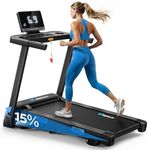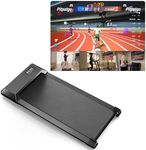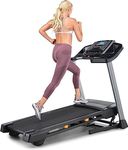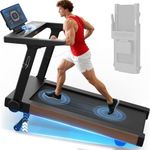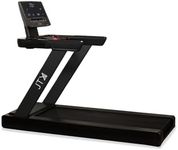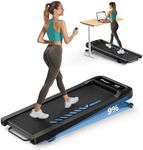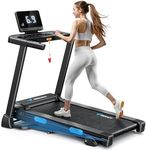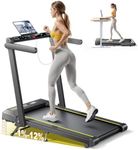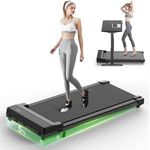Buying Guide for the Best Walking Treadmills
Choosing the right walking treadmill involves understanding your personal fitness goals, available space, and the features that will best support your walking routine. Walking treadmills are designed to provide a convenient way to exercise indoors, and selecting the right one can enhance your workout experience and help you stay motivated. Consider factors such as the treadmill's size, motor power, speed range, and additional features that can make your workouts more enjoyable and effective.Motor PowerMotor power, measured in horsepower (HP), determines how smoothly and efficiently the treadmill operates. For walking treadmills, a motor with 1.5 to 2.5 HP is generally sufficient. If you plan to use the treadmill for light walking, a motor on the lower end of this range will suffice. However, if you intend to walk more frequently or at a brisk pace, consider a motor closer to 2.5 HP for better durability and performance.
Speed RangeThe speed range of a treadmill indicates how fast the belt can move. For walking treadmills, a speed range of 0.5 to 4 mph is typically adequate. If you are a beginner or prefer a leisurely pace, a treadmill with a lower maximum speed will meet your needs. For those who want the option to walk briskly or incorporate interval training, look for a treadmill that offers speeds up to 4 mph or slightly higher.
Incline OptionsIncline options allow you to simulate walking uphill, which can increase the intensity of your workout and engage different muscle groups. Some treadmills offer manual incline adjustments, while others have motorized inclines. If you want to add variety to your workouts and challenge yourself, choose a treadmill with incline capabilities. Consider how often you plan to use this feature when deciding between manual and motorized options.
Deck SizeThe deck size refers to the walking surface area of the treadmill. A larger deck provides more room to walk comfortably, which is especially important for taller individuals or those with a longer stride. For walking, a deck length of 50 to 55 inches is usually sufficient. If space is limited in your home, you may need to balance deck size with the treadmill's overall footprint.
CushioningCushioning refers to the shock absorption system of the treadmill, which can reduce the impact on your joints while walking. This feature is particularly important if you have joint issues or plan to walk frequently. Treadmills with good cushioning can make your workouts more comfortable and reduce the risk of injury. Test the cushioning if possible, or look for reviews that mention the comfort level of the treadmill.
Console FeaturesConsole features include the display and controls on the treadmill, which can enhance your workout experience. Basic consoles show speed, time, distance, and calories burned, while more advanced models offer heart rate monitoring, workout programs, and connectivity options like Bluetooth. Consider what features will motivate you and help you track your progress. If you enjoy listening to music or watching videos while walking, look for a treadmill with media compatibility.
Portability and StoragePortability and storage are important if you have limited space or need to move the treadmill frequently. Some treadmills are foldable, making them easier to store when not in use. Consider the weight and ease of folding if you plan to store the treadmill regularly. If you have a dedicated space for your treadmill, portability may be less of a concern, but it's still worth considering if you anticipate rearranging your workout area.
